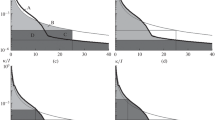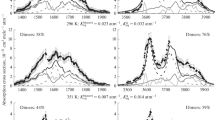Abstract
Further development of the asymptotic line wing theory is presented where the long-wave approximation for the molecular centers of mass is violated. This provides long molecular trajectories going far beyond an elementary volume in the case of nonresonance light absorption. The occurrence of long trajectories is evidence for a certain degree of ordering of molecular chaos. The latter can be described by means of a modified semiclassical representation method to establish correlation between the displacement and velocity operators. An expression for the absorption coefficient is derived that allows an ambiguity concerning the estimation of the parameters of the potentials to be avoided, and the temperature dependence of the absorption coefficient in line wings to be described. In our earlier work, calculations of the absorption coefficient were performed with violation of the long-wave approximation for molecular centers of mass for H2O molecule in the 8–12 μm region using a diffusion model. This model is also employed in the present work for H2O absorption in the 3–5 μm window regions and for CO2 absorption in the 4.3-μm band wing to describe the temperature dependence of the absorption coefficient. Long molecular trajectories essential for the 8–12 and 3–5 μm H2O regions are shown to hardly play a role in the 4.3-μm CO2 band wing.
Similar content being viewed by others
References
G. Hettner, “Infra-red absorption spectrum of watervapour,” Ann. Phys. (New York) 55 (6), 476–496 (1918).
Q. Ma, R. H. Tipping, and C. Leforestier, “Temperature dependences of mechanisms responsible for the watervapor continuum absorption: I. Far wings of allowed lines,” J. Chem. Phys. 128, 124313-1–124313-17 (2008).
Yu.V. Bogdanova and O.B. Rodimova, “Line shape in far wings and water vapor absorption in a broad temperature interval,” J. Quant. Spectrosc. Radiat. Transfer 111 (15), 2298–2307 (2010).
T. E. Klimeshina and O. B. Rodimova, “Temperature dependence of the water vapor continuum absorption in the 3–5 μm spectral region,” J. Quant. Spectrosc. Radiat. Transfer 119, 77–83 (2013).
I. V. Ptashnik, K. P. Shine, and A. A. Vigasin, “Water vapour self-continuum and water dimers: 1. Analysis of recent work,” J. Quant. Spectrosc. Radiat. Transfer 112, 1286–1303 (2011).
C. Leforestier, R. H. Tipping, and Q. Ma, “Temperature dependences of mechanisms responsible for the water-vapor continuum absorption. II. Dimers and collision-induced absorption,” J. Chem. Phys. 132 (16), 164302-1–164302-14 (2010).
A. Brown and R. H. Tipping, “Collision-induced absorption in dipolar molecule - homonuclear diatomic pairs,” in Weakly Interacting Pairs: Unconventional Absorbers of Radiation in the Atmosphere, Ed. by C. Camy-Peyret and A.A. Vigasin (Kluwer Academic, Dordrecht, 2003).
Yu. I. Baranov, W. J. Lafferty, Q. Ma, and R. H. Tipping, “Water-vapor continuum absorption in the 800–1250 cm–1 spectral region at temperatures from 311 to 363 K,” J. Quant. Spectrosc. Radiat. Transfer 109, 2291–2302 (2008).
Yu. I. Baranov and W. J. Lafferty, “The water-vapor continuum and selective absorption in the 3-5 μm spectral region at temperatures from 311 To 363 K,” J. Quant. Spectrosc. Radiat. Transfer 112, 1304–1313 (2011).
Yu. I. Baranov, “The continuum absorption in H2O–N2 mixtures in the 2000–3250 cm–1 spectral region at temperatures from 326 to 363 K,” J. Quant. Spectrosc. Radiat. Transfer 112, 2281–2286 (2011).
D. J. Paynter, I. V. Ptashnik, K. P. Shine, and K. M. Smith, “Pure water vapor continuum measurements between 3100 and 4400 cm–1: Evidence for water dimer absorption in near atmospheric conditions,” Geophys. Res. Lett. 34, L12808 (2007).
D. J. Paynter, I. V. Ptashnik, K. P. Shine, K. M. Smith, R. M. McPheat, and R. G. Williams, “Laboratory measurements of the water vapor continuum in the 1200–8000 cm–1 region between 293 and 351 K,” J. Geophys. Res. 114, D21301-1–D21301-23 (2009).
I. V. Ptashnik, R. A. McPheat, K. P. Shine, K. M. Smith, and R. G. Williams, “Water vapor selfcontinuum absorption in near-infrared windows derived from laboratory measurements,” J. Geophys. Res. 116, D163057 (2011).
I. V. Ptashnik, R. A. McPheat, K. P. Shine, K. M. Smith, and R. G. Williams, “Water vapour foreign- continuum absorption in near-infrared windows from laboratory measurements,” Phil. Trans. Roy. Soc. A 370 (1968), 2557–2577 (2012).
I. V. Ptashnik, T. M. Petrova, Yu. N. Ponomarev, K. P. Shine, A. A. Solodov, and A. M. Solodov, “Near-infrared water vapour self-continuum at close to room temperature,” J. Quant. Spectrosc. Radiat. Transfer 120, 23–35 (2013).
W. E. Bicknell, S. D. Cecca, M. K. Griffin, S. D. Swartz, and A. Flusberg, “Search for low-absorption regions in the 1.6- and 2.1-μm atmospheric windows,” J. Directed Energy 2, 151–161 (2006).
D. Mondelain, A. Aradj, S. Kassi, and A. Campargue, “The water vapour self-continuum by CRDS at room temperature in the 1.6 mm transparency window,” J. Quant. Spectrosc. Radiat. Transfer 130, P. 381–391 (2013).
D. E. Burch, Continuum Absorption by H 2 O. AFGLReport TR-0300 (AFGL, 1982).
D. E. Burch and R. L. Alt, Continuum Absorption by H 2 O in the 700–1200 cm –1 and 2400–2800 cm –1 windows. Report AFGL-TR-84-0128 (AFGL, 1984).
I. G. Kaplan and O. B. Rodimova, “Intermolecular interactions,” Sov. Phys. Usp. 21, 918–946 (1978).
I. G. Kaplan, Introduction in the Theory of Intermolecular Interactions (Nauka, Moscow, 1982) [in Russian].
I. G. Kaplan, Intermolecular Interactions: Physical Picture, Computational Methods and Model Potentials (John Wiley & Sons, Chichester, 2006).
T. L. Hill, “Molecular clusters in imperfect gases,” J. Chem. Phys. 23 (4), 617–622 (1955).
O. B. Rodimova, “Continuum water vapor absorption in the 4000-8000 cm−1 region,” Proc. SPIE—Int. Soc. Opt. Eng. 9680, 968002-1–968002-7 (2015).
E. P. Gordov and S. D. Tvorogov, Semiclassical Representation Method in the Quantum Theory (Nauka, Novosibirsk, 1984) [in Russia].
S. D. Tvorogov, E. P. Gordov, and O. B. Rodimova, “Intermolecular interactions and molecular spectroscopy: From the semiclassical representation of quantum theory to the line wing theory,” Atmos. Ocean. Opt. 20 (9), 692–695 (2007).
S. D. Tvorogov, “Problem of centers of mass within the problem of the contour of spectral lines. I. Existence of long trajectories,” Atmos. Oceanic Opt. 22 (3), 257–263 (2009).
L. I. Nesmelova, O. B. Rodimova, and S. D. Tvorogov, Spectral Line Contour and Intermolecular Interaction (Nauka, Novosibirsk, 1986) [in Russian].
S. D. Tvorogov and O. B. Rodimova, Collisional Contours of Spectral Lines (Publishing House of IAO SB RAS, Tomsk, 2013) [in Russian].
P. W. Rosenkranz, “Pressure broadening of rotational bands. I. A statistical theory,” J. Chem. Phys. 83 (12), 6139–6144 (1985).
S. D. Tvorogov and O. B. Rodimova, “Spectral line shape. I. Kinetic equation for arbitrary frequency detunings,” J. Chem. Phys. 102 (22), 8736–8745 (1995).
S. D. Tvorogov and O. B. Rodimova, “Asymptotic and quasistatic approaches in spectral line shape theory,” Opt. Atmos. Okeana 25 (1), 31–45 (2012).
C. B. Ludwig, C. E. Ferriso, W. Malkmus, and T. P. Boynton, “High-temperature spectra of the purerotational band of H2O,” J. Quant. Spectrosc. Radiat. Transfer 5 (4), 697–714 (1965).
P. Varanasi, S. Chou, and S. S. Penner, “Absorption coefficients for water vapor in the 600–1000 cm–1 region,” J. Quant. Spectrosc. Radiat. Transfer 8 (8), 1537–1541 (1968).
M. V. Tonkov and N. N. Filippov, “Effect of molecular interaction on the shap of rovibrational bands in gas spectra. Properties of the spectral function,” Opt. Spektrosk. 54 (5), 801–806 (1983).
Yu. V. Bogdanova and O. B. Rodimova, “Role of diffusion in the violation of the long-wave approximation in line wings,” Int. J. Quantum Chem. 112 (17), 2924–2931 (2012).
S. D. Tvorogov and O. B. Rodimova, “Centre-of-mass problem in the spectral line shape task. II. Wave function and density matrix of the light absorbing molecule after optically active collision,” Opt. Atmos. Okeana 23 (8), 633–639 (2010).
Ya. P. Terletskii, Statistical Physics (Vyssh. shk., Moscow, 1966) [in Russian].
O. Singh and A. W. Joshi, “Effective potential for water vapour,” Pramana 15 (5), 407–412 (1980).
A. H. Harvey and E. W. Lemmon, “Correlation for the second virial coefficient of water,” J. Phys. Chem. Ref. Data 33 (1), 369–376 (2004).
J. S. Rowlinson, “The second virial coefficients of polar gases,” Trans. Faraday Soc. 45, 974–984 (1949).
Yu. V. Bogdanova, T. E. Klimeshina, and O. B. Rodimova, “Description of the H2O absorption in the 3–5 μm region under violation of the long-wave approximation in line wings,” Proc. SPIE 9292, P. 92920G-1–92920G-6 (2014).
Yu. V. Bogdanova and O. B. Rodimova, “Accounting for diffusion during calculation of the absorption coefficient in the 4.3-μm CO2 band wing,” in Proc. of the XVII Intern. Symp. “Atmospheric and Ocean Optics. Atmospheric Physics” (Publishing House of IAO SB RAS, Tomsk, 2011), p. A-100–A-103 [in Russian].
J. M. Hartmann, M. Y. Perrin, Q. Ma, and R. H. Tipping, “The infrared continuum of pure water vapor: Calculations and high-temperature measurements,” J. Quant. Spectrosc. Radiat. Transfer 49 (6), 675–691 (1993).
C. Cousin, R. LeDoucen, C. Boulet, A. Henry, and D. Robert, “Line coupling in the temperature and frequency dependence of absorption in the microwindows of the 4.3-μm CO2 band,” J. Quant. Spectrosc. Radiat. Transfer 36 (6), 521–538 (1986).
O. B. Rodimova, “Spectral line profile of self-broadened CO2 from the center to the far wing,” Atmos. Ocean. Opt. 15 (9), 694–703 (2002).
Author information
Authors and Affiliations
Corresponding author
Additional information
Original Russian Text © Ju.V. Bogdanova, T.E. Klimeshina, O.B. Rodimova, 2016, published in Optika Atmosfery i Okeana.
The article was translated by the authors.
Rights and permissions
About this article
Cite this article
Bogdanova, J.V., Klimeshina, T.E. & Rodimova, O.B. Water vapor line wing absorption and violation of the long-wave approximation for molecular centers of mass. Atmos Ocean Opt 30, 111–122 (2017). https://doi.org/10.1134/S1024856017020063
Received:
Published:
Issue Date:
DOI: https://doi.org/10.1134/S1024856017020063




